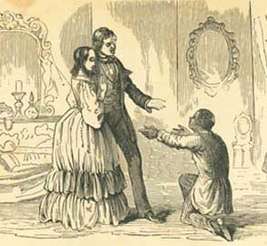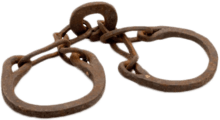Anti-Tom literature
Anti-Tom literature consists of the 19th century pro-slavery novels and other literary works written in response to Harriet Beecher Stowe's Uncle Tom's Cabin. Also called plantation literature, these writings were generally written by authors from the Southern United States. Books in the genre attempted to show either that slavery was beneficial to African Americans or that the evils of slavery as depicted in Stowe's book were overblown and incorrect.

Uncle Tom's Cabin
First published in serialized form from 1851–52 (in the abolitionist journal The National Era), and in book form in 1852, Uncle Tom's Cabin by Harriet Beecher Stowe quickly became the best-selling novel of the 19th century (and the second best-selling book of the century after the Bible).[1] This abolitionist novel focused on the evils of slavery and was inspired by the passage of the Fugitive Slave Act two years before, which punished those who aided runaway slaves. The book was highly controversial and fanned the debate over slavery in the country.
The Southern literary response
The response to Stowe's novel in the American South was one of outrage. To counter Stowe's novel, Southern writers produced a number of pro-slavery books, the vast majority of them novels. In 1852 alone, eight anti-Tom novels were published.[2]
These anti-Tom novels tended to feature a benign white patriarchal master and a pure wife, both of whom presided over childlike slaves in a benevolent extended-family-style plantation. The novels either implied, or directly stated, the view that African Americans were unable to live their lives without being directly overseen by white people.[3]
Today these novels and books are generally seen as pro-slavery propaganda. The anti-Tom genre died off with the start of the American Civil War.[4]
Simms, Hentz, and other pro-slavery authors
The two most famous anti-Tom books are The Sword and the Distaff by William Gilmore Simms and The Planter's Northern Bride by Caroline Lee Hentz.[2]
Simms' The Sword and the Distaff came out only a few months after Stowe's novel and contains a number of sections and discussions that clearly debate Stowe's book and view of slavery. The novel focuses on the Revolutionary War and its aftermath through the lives of Captain Porgy and one of his slaves.[4] Simms' novel was popular enough that it was reprinted in 1854 under the title Woodcraft.
The Planter's Northern Bride by Caroline Lee Hentz was published two years after Uncle Tom's Cabin. Hentz's novel offers a defense of slavery as seen through the eyes of a northern woman—the daughter of an abolitionist—who marries a southern slave owner. As with other books in the genre, Hentz's novel tries to show that black people lacked the ability to function well without oversight by whites. Her novel also focused on the fear of a slave rebellion, especially if abolitionists did not stop stirring up trouble.[2]
Simms and Hentz's books were two of between 20 or 30 pro-slavery novels written in the decade after Uncle Tom's Cabin. Another well-known author who published anti-Tom novels is John Pendleton Kennedy.[4]
Mary Henderson Eastman's Aunt Phillis's Cabin was one of the bestselling novels of the genre. Published in 1852, it sold 20,000 to 30,000 copies.[5] In a note in the book, Eastman proudly stated she was a descendant of the First Families of Virginia.
Little Eva: The Flower of the South, by Philip J. Cozans, was a rare example of anti-Tom literature intended to be a children's novel.[6]
Selected anti-Tom novels
Among the novels in the anti-Tom genre are:
- The Sword and the Distaff by William Gilmore Simms
- White Acre vs. Black Acre by William M. Burwell
- Ellen; or, The Fanatic's Daughter by Mrs. V.G. Cowdin
- Little Eva: The Flower of the South by Philip J. Cozans
- "Uncle Tom's Cabin" Contrasted with Buckingham Hall, the Planter's Home by Robert Criswell
- Aunt Phillis's Cabin: or, Southern Life As It Is by Mary H. Eastman
- Antifanaticism: A Tale of the South by Martha Haines Butt
- The Ebony Idol by Mrs. G.M. Flanders
- Liberia; or, Mr. Peyton's Experiments by Sarah Josepha Hale
- Frank Freeman's Barber Shop by the Rev. Baynard R. Hall
- The Planter's Northern Bride by Caroline Lee Hentz
- Tit for Tat by "A Lady of New Orleans"
- The Lofty and the Lowly, or Good in All and None All Good by M. J. McIntosh
- Uncle Robin, in His Cabin in Virginia, and Tom Without One in Boston by J. W. Page
- The Cabin and Parlor; or, Slaves and Masters by Charles Jacobs Peterson (under the pseudonym of J. Thornton Randolph)
- The North and the South; or, Slavery and Its Contrasts by Caroline Rush
- The Black Gauntlet: A Tale of Plantation Life in South Carolina by Mary Howard Schoolcraft
- Uncle Tom's Cabin As It Is (There were two novels published with this title, one by W.L. Smith - full title Life at the South; or, "Uncle Tom's Cabin" As It Is - and the other by C.H. Wiley)
- Mr. Frank, the Underground Mail-Agent by Vidi
- English Serfdom and American Slavery; or, Ourselves as Others See Us by Lucien Chase
- The Leopard's Spots, by Thomas Dixon Jr. (1901)
- The Clansman, by Thomas Dixon Jr. (1905)
See also
- African American literature
- Slave narratives
- Southern literature
References
- Notes
- Notes on Book, accessed Feb 16, 2007
- "Caroline Lee Hentz's Long Journey" by Philip D. Beidler. Alabama Heritage Number 75, Winter 2005.
- Joy Jordan-Lake, Whitewashing Uncle Tom's Cabin: Nineteenth-Century Women Novelists Respond to Stowe, Vanderbilt University Press, 2005
- Lucinda MacKethan, "An Overview of Southern Literature by Genre", Southern Spaces, February 16, 2004.
- Mary Henderson Eastman, Aunt Phillis's Cabin, University of Virginia, accessed 9 Dec 2008
- Philip J. Cozans, Little Eva: The Flower of the South, c. 1853
External links
| Wikimedia Commons has media related to Anti-Tom literature. |
